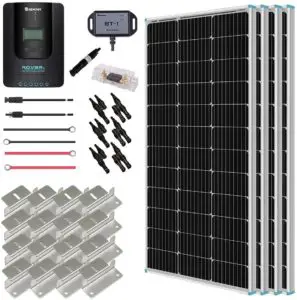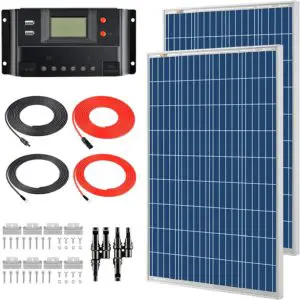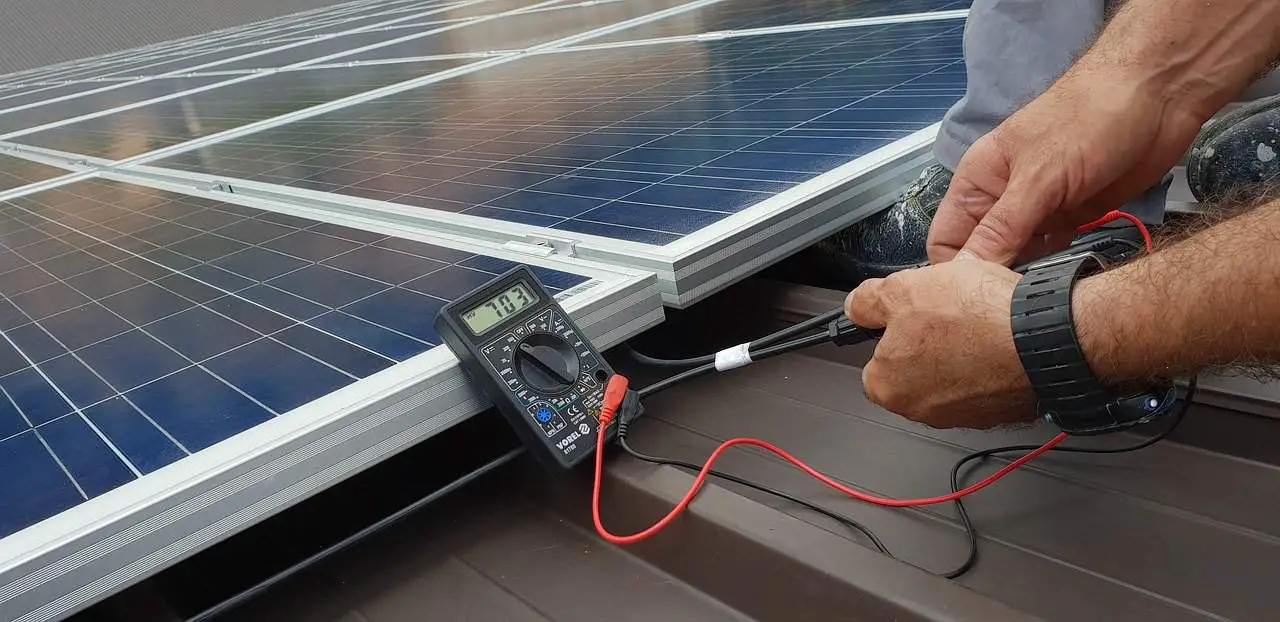One of the most energy-hungry appliances in any RV is the air conditioning unit. Due to the power required to run an AC, RVers typically choose to use either shore power or generators. But… can you run an RV AC on solar?
Technically, running an RV AC on solar is possible, so long as you’re able to generate enough power. But getting enough energy to support an AC with solar is both difficult and expensive, as it requires a large solar set up.
Although running your RV’s AC on solar is difficult, it’s not impossible. So, if you still plan on trying to use the power of the sun to run your RV’s most energy-hungry appliance, let’s examine how solar systems work, and what’s required for a functioning set up in your RV.
How Solar Power in an RV Works
In order to have solar power run appliances in your RV, there are a few necessary parts required: the solar panels themselves, batteries, a charge controller, and an inverter. Here’s a detailed breakdown of what you’ll need:
Solar Panels
Solar panels contain a number of cells which are responsible for capturing sunlight and converting it into usable energy. Connecting several panels together creates a solar array, which is a must for powering an RV air conditioner.
Here’s a simple breakdown of the three most common types of solar panels available on the market:
Amorphous Panels
These are the most affordable– but least efficient- solar panels available. They also take up the most space.
Amorphous panels can lose up to 30% of their power-generating capacity within the first year, which means they degrade quickly with prolonged exposure to sunlight.
The reason why these are the least expensive, but also the least energy-efficient is due to how they’re produced. Like all solar panels, amorphous panels are made of silicon, however, unlike mono- or polycystalline panels, they are made extremely thin, and are placed on substrates other than silicon. Although this makes these panels much less pricey than other options, they are also weaker, less dependable, and not meant to last.

Check Out Solar Panel on Amazon
Polycrystalline Panels
A step up from amorphous panels, polycrystalline panels take up about half the space to produce the same amount of power.
Something to keep in mind: Polycrystalline solar panels can vary greatly in their quality. Make sure to look for panels with the highest wattage rating in relation to size, ensuring the most efficiency.

Check Out Solar Panel on Amazon
Monocrystalline Panels
Monocrystalline is a definite step up from polycrystalline panels. Not only are they more efficient, but they also last longer, and are of greater value for the cost.
The magic of monocrystalline panels comes down to how they’re created: Made of single (or, “mono“) crystal silicon, electrons in these panels have more space to move around, creating more electricity from the sun.
This is compared to the less-efficient polycrystalline panels which contain many (or “poly“) crystals, which take up more room within the panels, not allowing electrons enough space to create the same amount of energy as their monocrystalline counterparts.

Check Out Solar Panel on Amazon
Beyond the three types of solar panels mentioned, there’s also the choice of rigid versus flexible panels. Rigid panels are popular due to their durability (made using tempered glass).
Batteries and Charge Controllers
The efficiency of a solar power system heavily relies on the ability of its batteries to store power. Valve-regulated lead-acid (VRLA) batteries are the most commonly used in RVs.
VRLA batteries are available in two types:
Absorbed Glass Mat (AGM) Batteries
The more popular option, AGM batteries are sealed so they don’t spill or release gas, demand no maintenance, charge quickly, and resist low temperatures. However, these batteries require a charge controller to prevent overcharging.
Gel Batteries
These are sealed as well, but take much longer to change thatn AGM batteries. They also require a charge controller compatible with the older technology of gel models.
Charge Controllers
A crucial part of our RV solar system is the charge controller; It prevents overcharging to maintain the life of the battery.
The controller allows a full flow of current from the solar panels to your battery when it’s low on power. When your battery is done charging, the controller restricts the flow of current from the solar panels to the battery, effectively avoiding overcharging.
Inverters
Power stored and provided by RV batteries is Direct Current (DC). However, the majority of appliances in your RV require Alternating Current (AC) to operate.
If you need to plug an appliance into the wall, that means it uses AC power. (For a quick run-down on AC/DC Power in Your RV or Van, read this.)
Basically, the purpose of power inverters is to convert DC to AC. This is a critical piece of a solar system as RV air conditioners run on Alternating Current. (For a full explanation on How RV Inverters Work, read this!)
Power Requirements for Running RV AC on Solar
Installation of a solar power system isn’t too complex once you undertand the flow of energy from the panels, to the battery, and to AC or DC via an inverter.
See? That’s pretty simple!
However, the possibility of using solar power to run an RV air conditioner comes down to selecting the right size of each component to deliver enough electricity according to the power demand of your AC unit.
Here’s a step-by-step guide to determining if running your AC on solar is possible in your RV:
Calculating How Many Amps Your AC Pulls
Calculating how many amps your RV’s AC pulls during operation is the first step to take in determining if running it with solar is possible.
Generally, a standard RV AC has a 13,500 BTU rating. Of course, some RVs come with larger AC units, rated much higher. BTU requirements are determined by the square footage of your RV- depending on the size of the space the AC unit needs to cool. Smaller RVs require less BTUs, while large RVs will require higher BTUs. (For a helpful guide to square footage and BTU requirements, check out this chart!)
Know that air conditioners require more energy to start, but after a few seconds, the necessary electrical surge will lessen, then run consistently on slightly lower energy. Take this into account when determining your BTU requirements.
Determine the Number of Solar Panels Needed
Knowing the amps draw by your AC will help determine the number of solar panels you should install. The number of hours per day you’re planning to run your AC also need to be determined.
For example, suppose you run your air conditioner for four hours per day, depending on your AC unit, this could pull 600 Amp hours (Ah) per day from your batteries, while running it for five hours might draw 750 Ah.
Assuming your RV only receives five hours of direct sunlight during the day, your solar panels will need to produce 120 amps for those full five hours every day to sufficiently charge your batteries. And remember: This is only calculating your air conditioner’s needs; This doesn’t include the energy requirements for any other Alternating Current appliances you want to use in your RV (ie water pump, microwave, TV, hairdryer, coffee maker, etc.).
So, make sure to calculate your total energy needs, otherwise, you might have air conditioning, but nothing else!
Now, as an example, to efficiently operate a 13,500 BTU AC unit in your RV, you’ll need to install at least 1,728 Watts worth of solar panels. Note that this basic calculation is based on your solar panels getting direct sunlight for five full hours every day; You’ll need to know how much sunlight your area receives, on average. If you’re in an area that rains often, or doesn’t get much sunlight, you’ll need to take this into account.
Choosing Your Battery Bank’s Capacity
As a rule of thumb, the larger the bank capacity, the longer you’ll be able to run your RV’s AC, during cloudy days or overnight.
If you’re working with an AC that pulls 150 amps, you’re going to need an extra 150 Ah of capacity for every hour that your AC unit is running in the absence of direct sunlight.
Suppose you like to run the AC an hour before going to bed. This requires an additional 150 Ah of battery capacity that your original setup may not have accounted for.
To solve this issue, if the current capacity is, say, 600 Ah, you’ll need to boost it up to 750 Ah or more.
In order to properly calculate the minimum Ah capacity your solar power system requires, you’ll need to consider the following:
- Your average electrical usage per day (measured in Watt-hours)
- The number of days you want to have your backup capacity available in case of an emergency, or simply, if you’re planning on living off-grid
- The average depth of discharge for your current battery bank
- The average temperature that your batteries will be subjected to while you’re on the road
Choosing the Size of an Inverter
Lastly, the most crucial component to consider is the DC-to-AC inverter. Its size will mainly depend on the starting wattage of your RV’s air conditioner.
The starting wattage of most 13,500 BTU air conditioners is between 2,800 and 3,000. However, you should avoid maxing out your inverter, so choosing an inverter between 3,500 and 4,000 watts is a often a better decision.
Pros of Running an RV AC on Solar
- Solar energy is a 100% renewable source of power
- Solar reduces the cost of electricity- off grid energy is free!
- Solar energy offers a wide range of applications, as it can be used to power any appliance with an inverter (so long as you can get enough energy)
- Solar panels, as well as the rest of the components, do not require a lot of maintenance. Clean them routinely, and solar panels should last a long time
Cons of Running an RV AC on Solar
- Initial costs can be expensive: Solar panels, batteries, and an inverter can add up to a few thousand dollars
- Weather dependent. If it’s cloudy or rainy, getting enough energy will prove to be a problem
- Solar panels can take up a lot of space, especially with high electricity demands
Wrap Up
While running your RV’s AC on solar is- technically- possible, the energy and space requirements to do so are difficult to satisfy.
Not only do AC’s need a lot of energy to run, every other appliance in your RV needs to be taken into consideration when calculating your daily power needs and the size of your solar array.
So, although it can be done, most RVers rely on other forms of power, such as generators, or plugging into shore power to run appliances that require so much energy.

